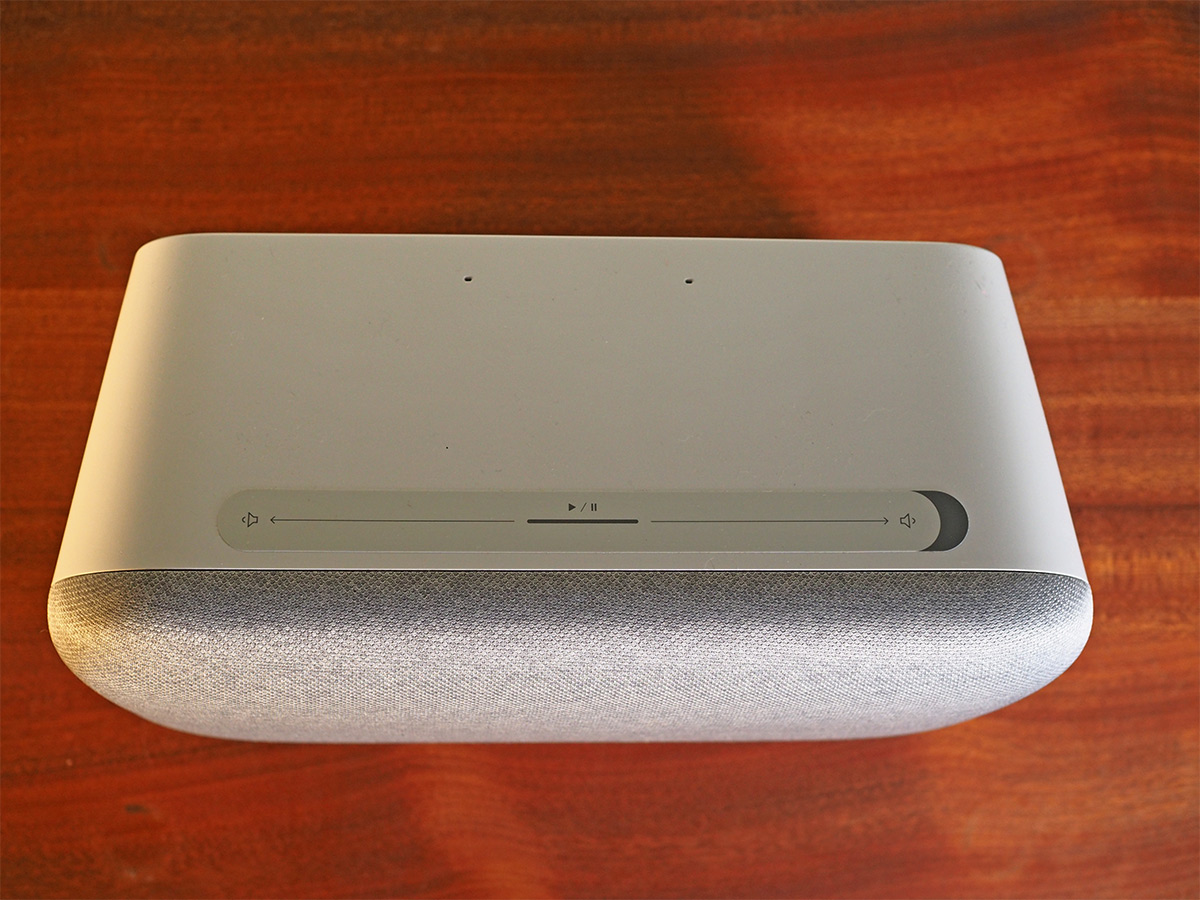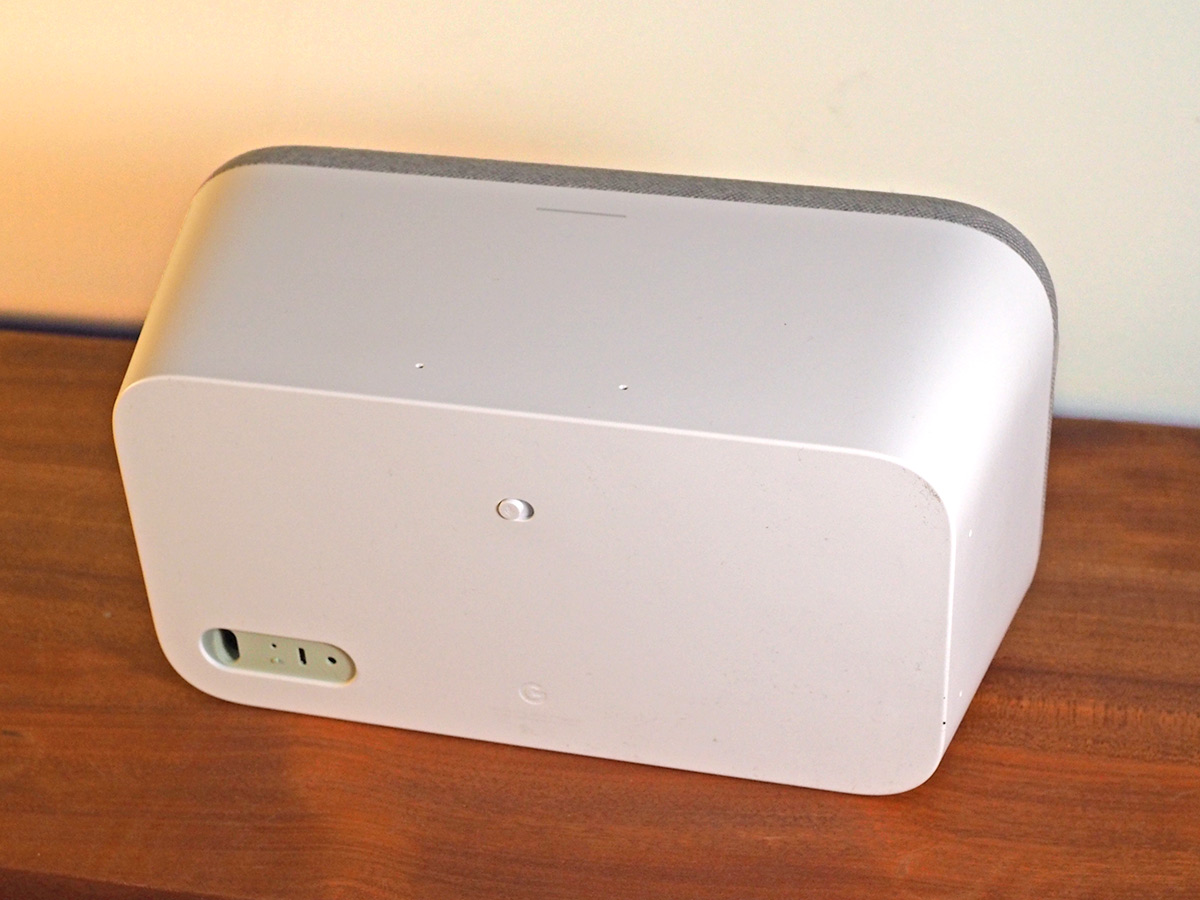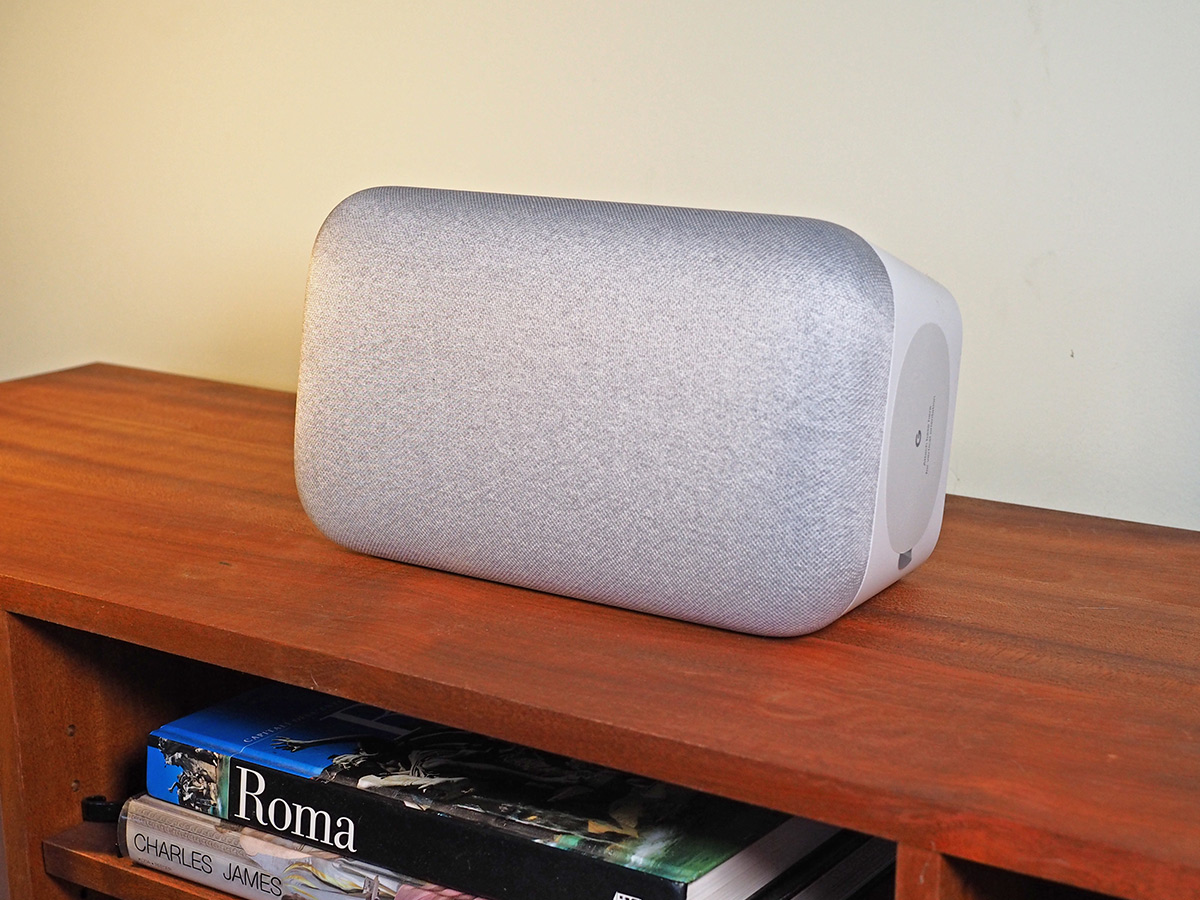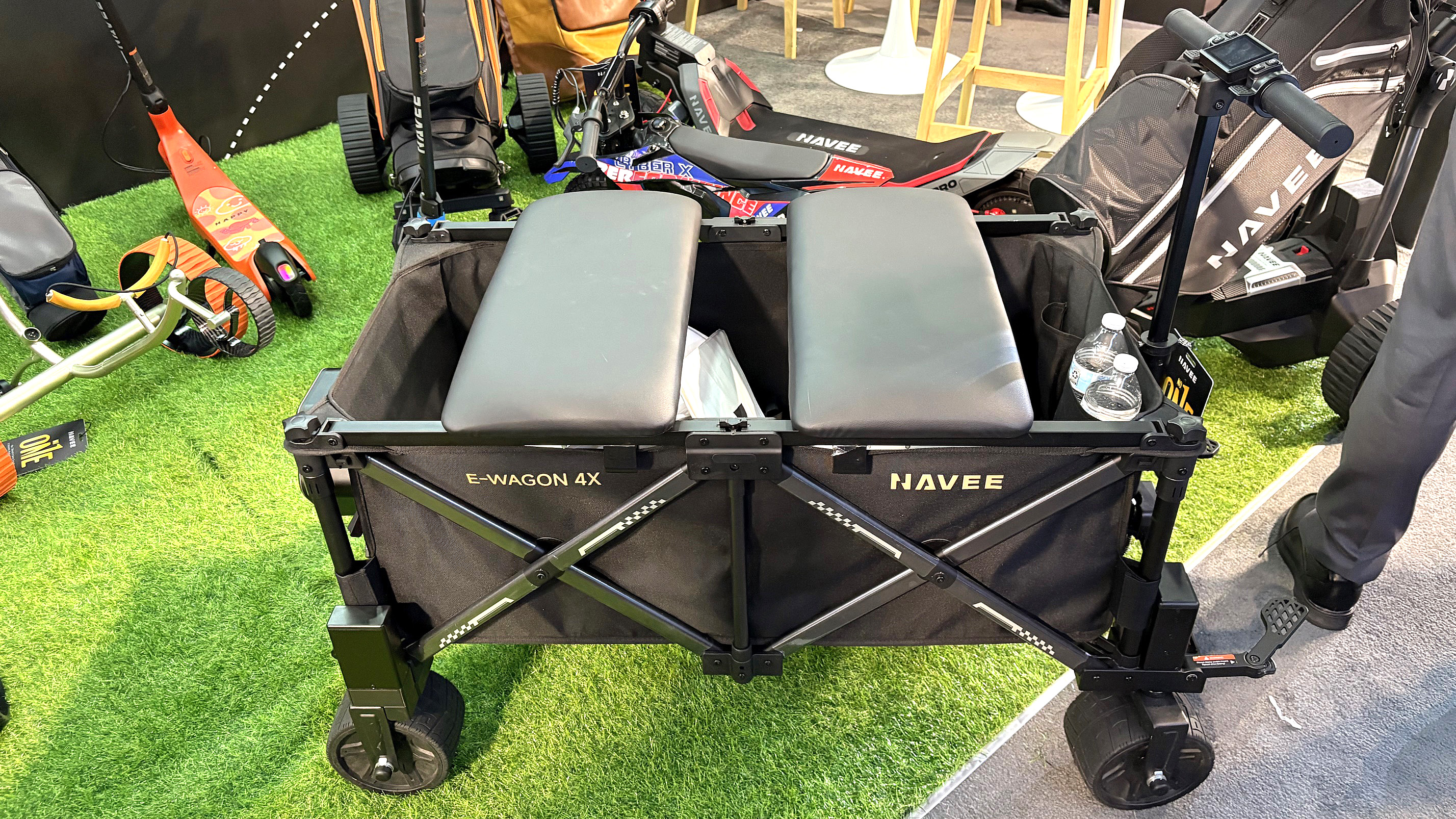Tom's Guide Verdict
Delivering powerful, booming audio, Google’s newest smart speaker is large and in charge.
Pros
- +
Great sound
- +
Audio-in lets you use Max as a TV speaker
- +
Booming audio
Cons
- -
Expensive
- -
Large
Why you can trust Tom's Guide
Tired of waiting for the Apple HomePod to arrive? The outstanding audio of the Google Home Max, coupled with the power of Google Assistant -- which will do everything from ordering food to turning your lights on and off, just by you speaking to the Max -- makes this $400 device a pricey but enticing option for those looking for a smart speaker that can do it all.
Design
Measuring 13.2 x 7.4 x 6 inches and weighing 11.7 pounds, the Google Home Max is aptly named. It's even larger than two Sonos One speakers placed side by side. However, Google designed this speaker to be as inconspicuous as possible. The front is covered with a gray fabric, while the rear and sides—which are roughly trapezoidal in shape and tapered toward the back — are a white plastic.
On the top of one of the long sides are touch controls for raising and lowering the volume, and a play/pause button in between. You can place the speaker in either a horizontal or vertical orientation -- but it's awkward to use the volume controls when the speaker is standing on its end.

Around the back of the Max is a switch to turn its microphone on and off, a USB-C port. and a 3.5mm audio jack. The latter is great for those who want to use the Max to power their TV audio (this is something I wish the Sonos One could do), but it would have been better had Google included an optical audio port.
Inside is Bluetooth 4.2 and 2.4 and 5-GHz 802.11ac Wi-Fi. I suspect audiophiles would also prefer an Ethernet jack (as on the Sonos One) to ensure a steady audio connection, but Wi-Fi should suffice for most everyone else. The Max is plenty loud on its own, but you can pair it with a second Max if you want truly booming audio.
Performance
Get instant access to breaking news, the hottest reviews, great deals and helpful tips.
Inside the massive Max are dual 4.5-inch woofers and dual 0.7-inch tweeters that deliver some truly impressive audio.

Smart Sound automatically adjusts the properties of the speaker to adapt to the room in which it's placed. It's similar to Sonos' TruePlay feature, but Sonos requires you to manually move your phone around the room as part of the tuning process.
The first song I played on the Max, Belle and Sebastian's "Another Sunny Day," had fairly crisp vocals, but the bass line was a bit too boomy for my tastes. Fortunately, you can manually adjust the equalizer settings in the Google Home app.
Tom Petty's strangled voice came through clearly on "I Won't Back Down," but the chorus sounded slightly compressed. Mick Jagger sounded great, as did Keith Richard's guitar licks, on "Beast of Burden."
The Max sounds great, that's for sure, but I was curious to see how it compared with the Sonos One, the best-sounding Alexa speaker out there. (For this review, I used two ($199) Sonos Ones -- which cost the same as a single Google Home Max -- paired in stereo mode.) I played the same tracks from Spotify, and for both the Sonos and the Max, I left the equalizer settings in the dead middle.

On the Max, the bass line in Bruce Springsteen's "Born to Run" was a little overwhelming; Clarence's sax solo didn't pop as much as I’d like, nor did Bruce's vocals. The Sonos Ones were more trebly, and Bruce's vocals were more forward and defined, as was Clemons' sax. However, higher tones, like cymbal crashes, were a bit harsh on the Sonos. I also had to turn up the volume a bit more on the Sonos speaker to match that of the Max.
A similar pattern emerged when I played "Sabotage" by the Beastie Boys. The Max was heavier on bass, while the Sonos speakers were more forward in the mids and trebles.

When playing "Take Five" on the Max, Paul Desmond's sax was mellifluous; it seemed to float above the piano and drums. On the Sonos Ones, Dave Brubeck's piano was a bit more present, as was the sax melody; it was sharper, but not as warm as on the Max. On the Sonos One, the drum solo was sharper and crisper than on the Max, and I could even pick out the sound of fingers strumming the bass.
Ultimately, between the two Sonos Ones and the single Google Max, it was too close to call. The Max provided deeper bass and was more powerful overall, while the Sonos speakers offered greater definition and, because there were two of them, greater flexibility in placing them in my rooms.
Streaming sources include YouTube Music, Pandora, Spotify, Google Play Music, TuneIn and iHeartRadio. That's a good mix, but Sonos has far more options, including Last.fm, Soundcloud, MLB and more.
Google Assistant: Getting Better, But Alexa Has More Skills
Central to any smart speaker is a voice assistant, which can perform a number of tasks just by you speaking to it. Naturally, the Max has Google Assistant built in, which can do everything from controlling your music and TV to making reservations and turning your lights on and off. Google Assistant can also answer questions, tell you the weather and traffic, manage your calendar, set alarms and more.
MORE: 32 Best Things Google Assistant Can Do
In our three-way competition with Alexa and Siri, Google Assistant came out on top, edging out Alexa by a single point. Google was the best when it came to general knowledge, entertainment, and voice recognition. But Alexa was better when it came to smart-home skills, music and online shopping.
The Sonos One is an Alexa-enabled speaker, so you can use it to access Amazon's assistant, but it doesn't have all of Alexa's features. Most notably, you can't use the Drop-In feature with the Sonos Ones, nor can you group them with non-Sonos speakers for whole-home audio. The closest competitors Amazon has to the Google Home Max right now are the all-new Echo ($99) and Echo Show ($229), but neither of them offer the sonic power of the Max.
Bottom Line
Overall, I was very impressed with the Google Home Max. It delivers booming audio, lets you connect it to your TV, and can control your smart home devices via Google Assistant. However, at $400, it's twice as expensive as the Alexa-equipped Sonos One, and $50 more than the upcoming Apple HomePod.
Credit: Tom's Guide

Michael A. Prospero is the U.S. Editor-in-Chief for Tom’s Guide. He oversees all evergreen content and oversees the Homes, Smart Home, and Fitness/Wearables categories for the site. In his spare time, he also tests out the latest drones, electric scooters, and smart home gadgets, such as video doorbells. Before his tenure at Tom's Guide, he was the Reviews Editor for Laptop Magazine, a reporter at Fast Company, the Times of Trenton, and, many eons back, an intern at George magazine. He received his undergraduate degree from Boston College, where he worked on the campus newspaper The Heights, and then attended the Columbia University school of Journalism. When he’s not testing out the latest running watch, electric scooter, or skiing or training for a marathon, he’s probably using the latest sous vide machine, smoker, or pizza oven, to the delight — or chagrin — of his family.

